|
Martin Wickremasinghe Folk Museum :
Tribute to the most outstanding 20th century Lankan writer
By Kurulu Kariyakarawana
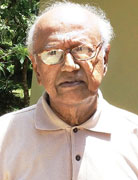 |
|
V.K. Wickremasinghe |
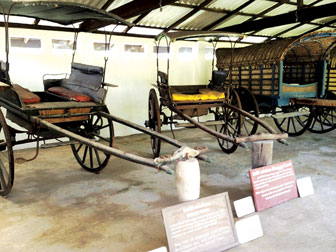 |
|
Gallery of Traditional
Transport |
“My physique developed in the same way that the bodies of other
Sinhala villagers grew. My mind developed in a different way. I did not
receive education from a prestigious school or a pundit. Knowledge came
to me from the books I read and through my life's experiences.
“The teacher who read me my first letter from an ola leaf manuscript
was not a man versed in Sanskrit and Pali. He did not even have a strong
command of the Sinhala language. Benefiting from the experience of
having taught the village children their letters for years, he was an
old man who was a good teacher. He won my respect and love and that of
my parents and sisters by teaching children the letters patiently,
joyfully and with a sense of calm control”.
The above was extracted from the autobiography, Upanda Sita (From the
beginning) of the most outstanding Lankan writer of the 20th century
Martin Wickremasinghe. Popularly known as the sage of Koggala, the small
southern coastal village where he was born on May 29, 1890 and died on
July 23, 1976 at the age of 86 ending an exceptional career dedicated to
the Sinhala language, its literature and folk culture. The much he had
contributed to society is immense.
Wickremasinghe who has written over a dozen novels including Madol
Doova, Gamperaliya, Viragaya, Kaliyugaya, Yuganthaya and Kaluwara Gedara
as well as over 100 publications of short stories, literary criticisms
and dramas in the areas of philosophy and allied subjects, evolution and
anthropology, history, travel, biology and autobiography have been
recognised locally and internationally as an eminent author.
Research
The research and studies he had done in the Sri Lankan folk culture,
finding the roots of ancient traditions have been of much use which are
preserved to date. However, this article is not about the great writer
himself but the folk culture museum set up to preserve his work and many
artefacts collected by him and his second generation.
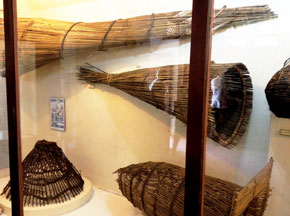 |
|
Traditional fishing
traps |
With his demise in 1976 a Trust was set up by his children who
decided to preserve his work and the Martin Wickremasinghe Folk Culture
Museum was established in Koggala. The museum was built in an eight-acre
land where his ancestral home lies which is over 200 years old. In 1983
the Government granted a certain extent of land to the original land
belonging to the ancestral home to establish the museum.
The Folk Culture Museum Complex consists of seven main sections as
the ancestral house where Wickramasinghe was born, the Hall of Life, the
Samadhi where his ashes have been interred, the Museum of Folk Culture,
the Exhibition of Traditional Transport, Fishing Boats and the Restored
Eco-environment.
The museum is maintained by the Martin Wickremasinghe Trust
comprising Chairman Ven Akuretyiye Amarawansa Nayaka Thera, Chairman of
the Board of Trustees and the elder son S K Wickremasinghe, second son
and Trustee V.K. Wickremasinghe, Secretary and the third son Dr. Ranga
Wickremasinghe, daughter and trustee Rupa Saparamadu and Trustees Dr.
H.R. Wickremasinghe, Maninda Wickremasinghe, Dr. Gunadasa Amarasekara
and Gunasena Vithana.
The Museum of Folk Culture exhibits a wide range of folk artefacts
found in the main traditional industries of farming and fishing which
were the two chief livelihoods of the people of Koggala. Also religious
artefacts of Buddhist statues, stupas, items used by Bhikkhus made out
of various material including bronze are displayed along with separate
galleries for traditional costumes and dresses, needle weaving,
puppetry, masks, furniture and kitchen utensils.
One section depicts how the traditional literature was written using
ola leaves and how the children were taught their first letters by
writing on sand boards and the evolution of the Sinhala alphabet.
Fishing
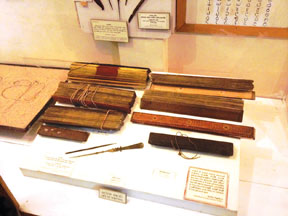 |
|
Traditional literature
and ola leaves |
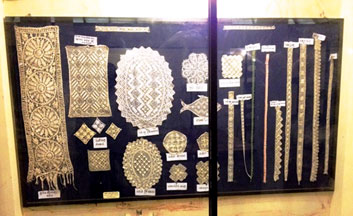 |
|
Traditional needle
weaving |
In the traditional industries section the various types of equipment
and accessories used in fishing and farming are displayed. The types of
vessels, boats, fishing traps and items related to paddy farming such as
ploughs and rice measuring vessels.
A range of masks is prominent among the many exhibits in the museum.
All types of masks used in traditional folk drama are displayed here
along with puppets of the Ambalangoda era. The typical kitchen of a
Sinhala home is another part where an entire kitchen with all its
effects is set up. The types of cooking utensils, vessels, spoons,
coconut scrapers used by the ancient Sinhala families are also seen.
Another main attraction is the gallery of traditional transport where
a range of carts and buggies are displayed in a separate section outside
the main gallery. A collection of over 20 varieties of bullock carts is
displayed here which had been used to transport people and logistics.
Two of the most interesting vehicles are the single person cart or
commonly referred to as the Bana Karattaya for transporting monks and
the huge cart pulled by an elephant.
The latter had been donated to the museum by the former Prime
Minister Sirmavo Bandaranaike.
Explaining the history of the land of the museum, one of the trustees
V.K. Wickremasinghe said the land was once taken over by the Royal Air
Force in 1942 during World War II to use it as as an airbase. The house
and the land was later handed back to the family.
The Folk Culture Museum is maintained by the Martin Wickremasinghe
Trust funded solely by the financial contributions of the family members
including the eldest sibling S.K. Wickremasinghe. It has been ascribed
by many schools as a place with an educational interest for
schoolchildren who visit it in large numbers throughout the year. The
income from the entrance fee charged from visitors barely meets the
maintenance cost of the entire museum complex which has to be undertaken
by the Trust Fund.
One thing a visitor would not miss is the flat elevated square of
land being established next to the ancestral home of the late
Wickremasinghe covered with a special type of grass. The Samadhi is the
place where the ashes of Martin Wickremasinghe and his wife Prema
Wickremasinghe had been interred. |


